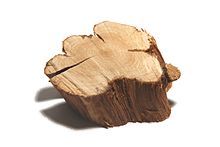A woody plant is a plant that produces wood as its structural tissue. Woody plants are usually either trees, shrubs, or lianas. These are usually perennial plants whose stems and larger roots are reinforced with wood produced from secondary xylem. The main stem, larger branches, and roots of these plants are usually covered by a layer of bark. Wood is a structural cellular adaptation that allows woody plants to grow from above ground stems year after year, thus making some woody plants the largest and tallest terrestrial plants.
A section of rosemary stem, an example of a woody plant, showing a typical wood structure.
Wood is primarily composed of xylem cells with cell walls made of cellulose and lignin. Xylem is a vascular tissue which moves water and nutrients from the roots to the leaves. Most woody plants form new layers of woody tissue each year, and so increase their stem diameter from year to year, with new wood deposited on the inner side of a vascular cambium layer located immediately beneath the bark. However, in some monocotyledons such as palms and dracaenas, the wood is formed in bundles scattered through the interior of the trunk.
Woody herbs are herbaceous plants that develop hard woody stems. They include such plants as Uraria picta and certain species in family Polygonaceae. These herbs are not truly woody but have hard densely packed stem tissue. Other herbaceous plants have woody stems called a caudex which is a thickened stem base often found in plants that grow in alpine or dry environments.
Under specific conditions, woody plants may decay or may in time become petrified wood.
The symbol for a woody plant, based on Species Plantarum by Linnaeus is  , which is also the astronomical symbol for the planet Saturn.
, which is also the astronomical symbol for the planet Saturn.
References- ^ Chase, Mark W. (2004). "Monocot relationships: an overview". Am. J. Bot. 91 (10): 1645–1655. doi:10.3732/ajb.91.10.1645. PMID 21652314.
- ^ Stearn, William T. (1992) [1966]. Botanical Latin (Fourth ed.). Portland: Timber Press. ISBN 0881923214.
- Wikipedia






No comments:
Post a Comment